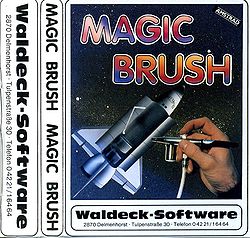Difference between revisions of "Magic Brush"
(Transfer Magic Brush article from old WIki) |
m (downside) |
||
| Line 4: | Line 4: | ||
The program was developed completely in Z80 assembler and sported a menu-driven graphical user interface. It provided various drawing modes (airbrush, pencil, polygons, circles and ellipses, patterned and plain fill) and image manipulation tools like (rectangular) copy and paste, rotation, and mirroring. It also included a character editor, zoom mode, and the creation of clip-art. | The program was developed completely in Z80 assembler and sported a menu-driven graphical user interface. It provided various drawing modes (airbrush, pencil, polygons, circles and ellipses, patterned and plain fill) and image manipulation tools like (rectangular) copy and paste, rotation, and mirroring. It also included a character editor, zoom mode, and the creation of clip-art. | ||
| + | A downside was that it was not possible to hide the menu and paint behind it, so eight lines at the bottom screen of the pictures made were solid background color only. | ||
The program was shipped with a small, freely distributable Basic extension called [[Magic Basic]] that allowed the use of the generated graphics in Basic programs. | The program was shipped with a small, freely distributable Basic extension called [[Magic Basic]] that allowed the use of the generated graphics in Basic programs. | ||
[[Category:Applications]] | [[Category:Applications]] | ||
Latest revision as of 04:27, 7 August 2011
Magic Brush was a graphics editor for the CPC 464, developed by Stephan Schulz and marketed by Waldeck Software in Germany.
The program was developed completely in Z80 assembler and sported a menu-driven graphical user interface. It provided various drawing modes (airbrush, pencil, polygons, circles and ellipses, patterned and plain fill) and image manipulation tools like (rectangular) copy and paste, rotation, and mirroring. It also included a character editor, zoom mode, and the creation of clip-art. A downside was that it was not possible to hide the menu and paint behind it, so eight lines at the bottom screen of the pictures made were solid background color only.
The program was shipped with a small, freely distributable Basic extension called Magic Basic that allowed the use of the generated graphics in Basic programs.
